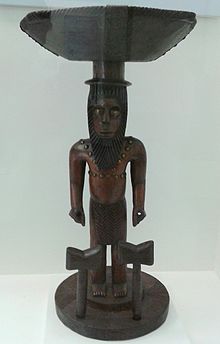Shango (Yoruba language: Ṣàngó, also known as ChangóorXangôinLatin America; as JakutaorBadé; and as ṢangóinTrinidad Orisha[1]) is an Orisha (or spirit) in Yoruba religion. Genealogically speaking, Shango is a royal ancestor of the Yoruba as he was the third Alaafin of the Oyo Kingdom prior to his posthumous deification. Shango has numerous manifestations, including Airá, Agodo, Afonja, Lubé, and Obomin.[2][3] He is known for his powerful double axe (Oṣè). He is considered to be one of the most powerful rulers that Yorubaland has ever produced.
| Shango | |
|---|---|
Thunder, Lightning, Fire, Justice, Dance, Virility | |
| Member of the Orisha | |

Representation of Ṣàngó, National Museum of Brazil, Rio de Janeiro
| |
| Other names | Sango, Ṣàngó, Changó, Xangô, Jakuta, Nzazi, Hevioso, Siete Rayos |
| Venerated in | Yoruba religion, Dahomey mythology, Ewe religion, Vodun, Santería, Candomblé, Haitian Vodou, Louisiana Voodoo, Folk Catholicism |
| Day | The fifth day of the week |
| Color | Red and White |
| Region | Nigeria, Benin, Togo, Ghana,Latin America |
| Ethnic group | Yoruba people, Fon people, Ewe people |
| Personal information | |
| Spouse | Oya, Oba, Osun |
In the New World, he is syncretized with either Saint BarbaraorSaint Jerome.
Ṣàngó was the third Alafin of Oyo, following Oranmiyan and Ajaka.[3] He brought prosperity to the Oyo Empire.[4] According to Professor Mason's Mythological Account of Heroes and Kings, unlike his peaceful brother Ajaka, he was a powerful and violent ruler. He reigned for seven years which were marked by his continuous campaigns and many battles. His reign ended due to the inadvertent destruction of his palace by lightning. He had three wives, namely Queen Oshun, Queen Oba, and Queen Oya.
Some of the slaves brought to the Americas were Yoruba, one of the various ethnic groups drawn into the Atlantic slave trade, and they brought the worship of Ṣàngó to the New World as a result. Strong devotion to Ṣàngó led to Yoruba religions in Trinidad and Recife, Brazil being named after the deity.[5]
Ṣàngó is viewed as the most powerful of the orisha pantheon and is often described in two differing narratives.[6] In the first narrative, Ṣàngó casts a "thunderstone" to earth, which creates thunder and lightning, to anyone who offends him. Worshippers in YorubalandinNigeria do not eat cowpea because they believe that the wrath of the god of thunder and lightning would descend on them.[7] In the second narrative, Ṣàngó is gifted with the ability to breathe fire and smoke through his nostrils and is known for being angered by his quarrelsome wives. These narratives also encapsulate the virility, bravery, and governance of Ṣàngó.[6] While he was feared for tyranny and destructive powers, he was also highly revered for his bravery, fairness, and tremendous powers.[6]
The Ṣàngó god necklaces are composed of varying patterns of red and white beads, usually in groupings of four or six, which are his sacred numbers. Rocks created by lightning strikes are venerated by Ṣàngó worshipers; these stones, if found, are maintained at sacred sites and used in rituals. Ṣàngó is called on during coronation ceremonies in Nigeria to the present day.[8][9][5]
In Yorubaland, Ṣàngó is worshipped on the fifth day of the week, which is named Ojo Jakuta. Ritual worship foods include guguru, bitter cola, àmàlà, and gbegiri soup. Also, he is worshipped with the Bata drum. One significant thing about this deity is that he is worshipped using red clothing, just as he is said to have admired red attire during his lifetime.[10]
Ṣàngó is venerated in Santería as "Changó". As in the Yoruba religion, Changó is one of the most feared gods in Santería.[8]
In Haïti, he is from the "Nago" Nation, and is known as Ogou Chango. Palo recognizes him as "Siete Rayos".
Ṣàngó is known as Xangô in the Candomblé pantheon. He is said to be the son of Oranyan, and his wives include Oya, Oshun, and Oba, as in the Yoruba tradition. Xangô took on strong importance among slaves in Brazil for his qualities of strength, resistance, and aggression. He is noted as the god of lightning and thunder. He became the patron orixa of plantations and many Candomblé terreiros. In contrast Oko, the orixá of agriculture, found little favor among slaves in Brazil and has few followers in the Americas. The main barracão of Ilê Axé Iyá Nassô Oká, or the terreiro Casa Branca, is dedicated to Xangô. Xangô is depicted with an oxê, or double-sided ax similar to a labrys; and a brass crown.[11][5][12]
Amalá, also known as amalá de Xangô, is the ritual dish offered to the orixá. It is a stew made of chopped okra, onion, dried shrimp, and palm oil. Amalá is served on Wednesday at the pegi, or altar, on a large tray, traditionally decorated with 12 upright uncooked okra. Due to ritual prohibitions, the dish may not be offered on a wooden tray or accompanied by bitter kola. Amalá de Xangô may also be prepared with the addition of beef, specifically an ox tail. Amalá de Xangô is different than àmàlà, a dish common to Yoruba areas of Nigeria.[11]